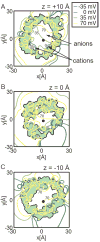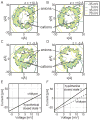The electrostatics of VDAC: implications for selectivity and gating
- PMID: 20005234
- PMCID: PMC3736979
- DOI: 10.1016/j.jmb.2009.12.006
The electrostatics of VDAC: implications for selectivity and gating
Abstract
The voltage-dependent anion channel (VDAC) is the major pathway mediating the transfer of metabolites and ions across the mitochondrial outer membrane. Two hallmarks of the channel in the open state are high metabolite flux and anion selectivity, while the partially closed state blocks metabolites and is cation selective. Here we report the results from electrostatics calculations carried out on the recently determined high-resolution structure of murine VDAC1 (mVDAC1). Poisson-Boltzmann calculations show that the ion transfer free energy through the channel is favorable for anions, suggesting that mVDAC1 represents the open state. This claim is buttressed by Poisson-Nernst-Planck calculations that predict a high single-channel conductance indicative of the open state and an anion selectivity of 1.75--nearly a twofold selectivity for anions over cations. These calculations were repeated on mutant channels and gave selectivity changes in accord with experimental observations. We were then able to engineer an in silico mutant channel with three point mutations that converted mVDAC1 into a channel with a preference for cations. Finally, we investigated two proposals for how the channel gates between the open and the closed state. Both models involve the movement of the N-terminal helix, but neither motion produced the observed voltage sensitivity, nor did either model result in a cation-selective channel, which is observed experimentally. Thus, we were able to rule out certain models for channel gating, but the true motion has yet to be determined.
Copyright (c) 2009. Elsevier Ltd. All rights reserved.
Figures







Similar articles
-
The crystal structure of mouse VDAC1 at 2.3 A resolution reveals mechanistic insights into metabolite gating.Proc Natl Acad Sci U S A. 2008 Nov 18;105(46):17742-7. doi: 10.1073/pnas.0809634105. Epub 2008 Nov 6. Proc Natl Acad Sci U S A. 2008. PMID: 18988731 Free PMC article.
-
An N-terminal nucleotide-binding site in VDAC1: involvement in regulating mitochondrial function.J Cell Physiol. 2007 Aug;212(2):551-61. doi: 10.1002/jcp.21048. J Cell Physiol. 2007. PMID: 17503466
-
Concentration dependent ion selectivity in VDAC: a molecular dynamics simulation study.PLoS One. 2011;6(12):e27994. doi: 10.1371/journal.pone.0027994. Epub 2011 Dec 2. PLoS One. 2011. PMID: 22164223 Free PMC article.
-
Emerging issues of connexin channels: biophysics fills the gap.Q Rev Biophys. 2001 Aug;34(3):325-472. doi: 10.1017/s0033583501003705. Q Rev Biophys. 2001. PMID: 11838236 Review.
-
The VDAC channel: Molecular basis for selectivity.Biochim Biophys Acta. 2016 Oct;1863(10):2498-502. doi: 10.1016/j.bbamcr.2016.01.019. Epub 2016 Jan 27. Biochim Biophys Acta. 2016. PMID: 26826035 Review.
Cited by
-
Affixing N-terminal α-helix to the wall of the voltage-dependent anion channel does not prevent its voltage gating.J Biol Chem. 2012 Mar 30;287(14):11437-45. doi: 10.1074/jbc.M111.314229. Epub 2012 Jan 24. J Biol Chem. 2012. PMID: 22275367 Free PMC article.
-
VDAC Modulation of Cancer Metabolism: Advances and Therapeutic Challenges.Front Physiol. 2021 Sep 29;12:742839. doi: 10.3389/fphys.2021.742839. eCollection 2021. Front Physiol. 2021. PMID: 34658929 Free PMC article. Review.
-
A size-modified poisson-boltzmann ion channel model in a solvent of multiple ionic species: Application to voltage-dependent anion channel.J Comput Chem. 2020 Jan 30;41(3):218-230. doi: 10.1002/jcc.26091. Epub 2019 Nov 14. J Comput Chem. 2020. PMID: 31845398 Free PMC article.
-
Charged residues distribution modulates selectivity of the open state of human isoforms of the voltage dependent anion-selective channel.PLoS One. 2014 Aug 1;9(8):e103879. doi: 10.1371/journal.pone.0103879. eCollection 2014. PLoS One. 2014. PMID: 25084457 Free PMC article.
-
Folded Structure and Membrane Affinity of the N-Terminal Domain of the Three Human Isoforms of the Mitochondrial Voltage-Dependent Anion-Selective Channel.ACS Omega. 2018 Sep 30;3(9):11415-11425. doi: 10.1021/acsomega.8b01536. Epub 2018 Sep 19. ACS Omega. 2018. PMID: 30320261 Free PMC article.
References
-
- Schein SJ, Colombini M, Finkelstein A. Reconstitution in planar lipid bilayers of a voltage-dependent anion-selective channel obtained from paramecium mitochondria. J Membr Biol. 1976;30:99–120. - PubMed
-
- Colombini M. Voltage gating in the mitochondrial channel, VDAC. J Membr Biol. 1989;111:103–11. - PubMed
-
- Adams JM, Cory S. The Bcl-2 protein family: arbiters of cell survival. Science. 1998;281:1322–6. - PubMed
-
- Shimizu S, Narita M, Tsujimoto Y. Bcl-2 family proteins regulate the release of apoptogenic cytochrome c by the mitochondrial channel VDAC. Nature. 1999;399:483–7. - PubMed
Publication types
MeSH terms
Substances
Grants and funding
LinkOut - more resources
Full Text Sources

